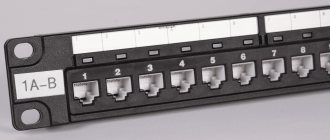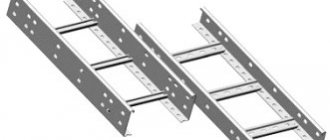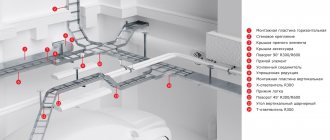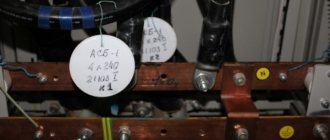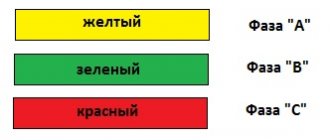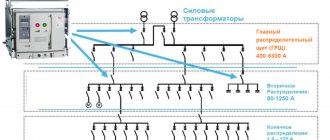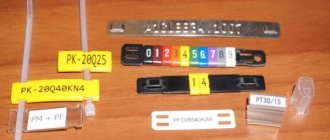In accordance with the operating rules for electrical installations, any cable line must have digital and/or letter designations. Often, when an electrical circuit includes several parallel conductors, a combined alphanumeric system is used. In such a situation, the cable tag of each core contains the same numerical value, but different letters of the Cyrillic or Latin alphabet.
The cable sleeve and exposed wires must be marked with tags indicating the number, line name, operating voltage, cross-sectional area and brand of electrical components used. All tags are characterized by resistance to negative environmental factors. The maximum allowable distance between tags is 50 m.
Purposes of wire markings
This process can significantly simplify electrical installation work, planned or emergency repairs, and maintenance of facilities and cable lines during operation. Another functional purpose is to reduce the likelihood of emergency situations and accompanying injuries to working personnel.
The cable is marked during the manufacturing process. The manufacturer must choose the color for the insulating sheath of the wire in accordance with international or domestic standards specified in PUE, PTEEP, GOSTs and other documentation. The data displayed on the outer sheath of the cable indicates information on several parameters:
- number of wires;
- cross-sectional area of the entire cable;
- insulating materials used;
- wire materials, etc.
Such marking, although necessary, is not sufficient to increase safety during the operation of cable lines. Based on it, maintenance specialists will not be able to draw clear conclusions about the purpose of the entire system or a specific section of electrical wiring. Therefore, when performing electrical installation work, additional abbreviations are applied to the cable, adding information about the purpose of the circuit to the characteristics.
Thanks to this, tags with the following data appear on the insulation:
- cable brand;
- purpose;
- the object associated with it;
- line length and other information if necessary.
Cable tags greatly simplify such marking, making it convenient and as fast as possible. They are selected depending on the diameter, characteristics and insulating materials on the wire. They may differ in a number of parameters, but have a common purpose and are capable of storing inscriptions for long periods of use.
Requirements for inscriptions on tags
Tags on the cable, secured with clamps or threaded through the wire, must be signed in a certain way; this rule is regulated by the rules of the PUE. In accordance with this document, the following data is applied to the label:
- Cable or line number. This is information that contains data about the direction of the highway, what it feeds, and what level of protection is required. During the wiring installation process, an object passport is drawn up, which indicates the buildings or premises powered by this line. They are assigned numbers, which will subsequently be written on the tag itself; during the service process, the technician will be able to look at the markings of the cables and, by comparing them with the object’s passport, understand where this or that line leads;
- Brand and cross-section of wire. Since space on the tag is limited, the designation is written abbreviated, with a minimum number of characters. For example, a vinyl-coated cable with a cross-section of 3*2.5 is briefly designated VVG-3/2.5;
- Line voltage. This is a mandatory parameter, since it is not clear from the outer sheath of the cables what voltage the current flows through it, respectively, and what level of protection is required during repair work;
- The beginning and end of cable lines. For more accurate information about possible losses on the main line after its installation, a designation of the total length is applied. After reading the data, the technician servicing the wire line will be able to accurately calculate the resistance and level of voltage loss in the network.
All of the information listed is basic and mandatory. It is not prohibited to place additional information on the tag that characterizes the electrical main, for example, the date of laying. In addition, when placing a tag on the coupling, it is necessary to place the date of installation of the wire, since the coupling has its own resource, which will be calculated based on this indicator.
Recently, to indicate the cable on the line, many electricians began to use stickers that already have inscriptions informing about the voltage, as well as empty spaces in which additional data is written. Such stickers are very convenient, since the master does not waste time making markings, but simply glues the element onto the finished tag and continues installation.
Expert opinion
It-Technology, Electrical power and electronics specialist
Ask questions to the “Specialist for modernization of energy generation systems”
Cable tags, requirements, and what needs to be written - review Marking tags are manufactured in accordance with TU 36-1440-82 Round tag U-135 is intended for power cables above 1000V; Square tag U-134 is intended for power cables up to 1000V; Triangular tag U-136 is intended for control cables. Ask, I'm in touch!
Requirements for types and methods of attaching tags
In addition to the placement of tags, all information about the markings produced on cable lines and communication devices is recorded in a special journal. Such records are regularly updated depending on changes that have occurred in the network structure.
Like cable, tags are made into specific shapes from a variety of materials. These can be ordinary labels, self-adhesives, plastic seals or polymer products used for high-quality and reliable marking of a bundle of several cores or one wire.
Ley Line Markers
In accordance with GOST, plastic plaques are made in square, round or triangular shapes. They are used in open areas of cable routes and circuit components. The tags have two holes through which the wire or core should be threaded, after which it is securely clamped and fixed in the desired position.
For lines whose voltage does not exceed 1000 V, square tags are used. If the operating voltage is above 1000 V, then round plastic plaques are used. Triangular products are required for control power lines.
Tags for low power circuits
For such purposes, small plates made of polymer materials can be used, which indicate information about the electricity consumption of the circuit subscriber and other data.
Important! Cable tags should even be used for hidden lines located inside pipes, manholes and blocks.
Excerpts from documents regulating the use of marking tags
SP 76.13330.2016 Electrical devices. Updated version of SNiP 3.05.06-85: P. 3.22.
Wires and cables laid in boxes and on trays must be marked at the beginning and end of the trays and boxes, as well as at the points where they are connected to electrical equipment, and the cables, in addition, also at route turns and branches. Marking of cable lines P. 3.103. Each cable line must be marked and have its own number or name. P. 3.104. Labels must be installed on exposed cables and cable joints. On cables laid in cable structures, tags must be installed at least every 50 - 70 m, as well as in places where the direction of the route changes, on both sides of passages through interfloor ceilings, walls and partitions, in places where cables enter (exit) into trenches and cable structures. On hidden cables in pipes or blocks, tags should be installed at the end points at the end couplings, in the wells and chambers of the block sewer system, as well as at each connecting coupling. On hidden cables in trenches, tags are installed at the end points and at each coupling. P. 3.105. Tags should be used: in dry rooms - made of plastic, steel or aluminum; in damp rooms, outside buildings and in the ground - made of plastic. Designations on tags for underground cables and cables laid in rooms with a chemically active environment should be made by stamping, punching or burning. For cables laid in other conditions, markings may be applied with indelible paint. P. 3.106. Tags must be secured to the cables with nylon thread or galvanized steel wire with a diameter of 1 - 2 mm, or plastic tape with a button. The place where the tag is attached to the cable with wire and the wire itself in damp rooms, outside buildings and in the ground must be covered with bitumen to protect it from moisture. Rules for the construction of electrical installations (PUE) clause 2.3.23. Each cable line must have its own number or name. If a cable line consists of several parallel cables, then each of them must have the same number with the addition of the letters A, B, C, etc. Openly laid cables, as well as all cable terminations, must be equipped with tags indicating on the tags of cables and terminations the brand, voltage, cross-section, number or name of the line; on the coupling tags - coupling numbers and installation dates. Tags must be resistant to environmental influences. On cables laid in cable structures, tags must be located along the length at least every 50 m. “Rules for the technical operation of consumer electrical installations” (PTEEP) 2.4.5.
Each CL must have a passport, including the documentation specified in clause 2.4.2. dispatch number or name. Openly laid cables, as well as all cable couplings, must be labeled; the cable tags at the beginning and end of the line must indicate the brand, voltage, cross-section, number or name of the line; on the coupling tags - coupling number, installation date. Tags must be resistant to environmental influences. They should be located along the length of the line every 50 m on openly laid cables, as well as at turns of the route and in places where cables pass through fire-resistant partitions and ceilings (on both sides). Marking tags are manufactured in accordance with TU 36-1440-82: Round tag (U-135) – intended for power cables above 1000V; Square tag (U-134) – designed for power cables up to 1000V; Triangular tag (U-136) – designed for control cables. Examples of cable tags:
Main types of cable markers
A marking tag in accordance with international standards must be installed on open cable routes and power installations. If the wire is laid in structures specially designed for this purpose, then the distance between the markers can be 50-70 m. You cannot do without them in a number of other cases:
- when the route crosses various obstacles that make visual inspection difficult (interfloor ceilings, walls, partitions), then tags are placed on each side of the obstacle passed (for example, on both sides of the wall);
- at points where the direction of the cable line changes;
- in places where input or output from other structures is carried out.
Many manufacturers and electricians prefer cable tags made of plastic, since such material can withstand moisture for a long time without changing its properties.
Form of marking tags
The rules and regulations indicate information on the forms of tags, which were described above:
- triangular - installed in cable lines for control or signaling purposes;
- square – for power lines with voltage up to 1 kV;
- round – over 1 kV.
Label sizes
The most common brands of cable tags are U-134, U-135, U-136 and U-153. Let's compare their sizes and, depending on the data obtained, draw conclusions on possible use in systems:
- U-134 is used to mark power lines with voltages not exceeding 1000 V. The square tag with an area of 55x55 mm is equipped with two 11x3.5 mm grooves for fixing with a cable binder.
- U-135 is suitable for indicating information on electrical circuits with voltages over 1000 V. Round products with a diameter of 55 mm and similar grooves for cable binders.
- U-136 is used for marking signal and control wires. The triangular product has equal sides 62 mm long each. There are two slots for a cable binder of the same size.
- U-153 is used for power lines with voltages up to 1000 V. A square product with a length of 28 mm and a 5 mm hole is attached using a special wire.
Important! Many organizations either ignore the cable tagging process or perform it using free-form tags. The consequences of both decisions can cause frequent emergencies and injury to operating personnel.
Color coding of wires and cables
Generally accepted standards and rules for color marking the insulating sheath of wires allow you to quickly and accurately determine the operating parameters of a cable and understand in which systems and devices it can be used. The color marking regulations are prescribed by PUE and GOST.
It is noteworthy that the designation system will be different for cable networks with alternating current or direct current. Often the cable is made in different colors. Instead of a shell, color marking can be done using heat-shrinkable tubes (cambrics). Another option is colored electrical tape. The choice of color for phase and neutral wires should always be different!
For three-phase alternating power lines, the buses should be marked as follows:
- first phase – yellow;
- the second is green;
- the third is red.
In DC cable runs, color designations are chosen according to the charge, which can be positive or negative. In the first case, a wire with a red braid is selected, in the second, a wire with a blue braid. The system does not support phase and neutral wires, and for the middle wire a light blue conductor is usually used.
For power installations with voltage up to 1 kV and neutral, the following marking is carried out:
- working neutral wire – blue;
- grounding – yellow-green;
- combined zero – yellow-green with blue markers (or blue with yellow-green markers);
- phases - red, black and other colors depending on the quantity.
It is noteworthy that the wiring inside electrical appliances is red, in sockets - brown.
Cable line tags
Normative base
The dimensions of the cable tags correspond to TU 36-1440-82: • TMARK-1 - square tags U-134 for power cables up to 1 kV;
• TMARK-4 - round tags U-135 for power cables over 1 kV; • TMARK-3 - triangular tags U-136 for control cable. Excerpts from documents regulating the use of marking tags.
SNIP 3-05-06-85 “Electrical devices”
SNIP 3-05-06-85 “Electrical technical devices” came into force on July 1, 1986 (Resolution of the USSR State Construction Committee dated December 11, 1985 N 215).
P. 3.22. Wires and cables laid in boxes and on trays must be marked at the beginning and end of the trays and boxes, as well as at the points where they are connected to electrical equipment, and the cables, in addition, also at route turns and branches. Marking of cable lines P. 3.103. Each cable line must be marked and have its own number or name. P. 3.104. Labels must be installed on exposed cables and cable joints. On cables laid in cable structures, tags must be installed at least every 50 - 70 m, as well as in places where the direction of the route changes, on both sides of passages through interfloor ceilings, walls and partitions, in places where cables enter (exit) into trenches and cable structures. On hidden cables in pipes or blocks, tags should be installed at the end points at the end couplings, in the wells and chambers of the block sewer system, as well as at each connecting coupling. On hidden cables in trenches, tags are installed at the end points and at each coupling. P. 3.105. Tags should be used: in dry rooms - made of plastic, steel or aluminum; in damp rooms, outside buildings and in the ground - made of plastic. Designations on tags for underground cables and cables laid in rooms with a chemically active environment should be made by stamping, punching or burning. For cables laid in other conditions, markings may be applied with indelible paint. P. 3.106. Tags must be secured to the cables with nylon thread or galvanized steel wire with a diameter of 1 - 2 mm, or plastic tape with a button. The place where the tag is attached to the cable with wire and the wire itself in damp rooms, outside buildings and in the ground must be covered with bitumen to protect it from moisture.
Rules for the construction of electrical installations (PUE)
clause 2.3.23. Each cable line must have its own number or name. If a cable line consists of several parallel cables, then each of them must have the same number with the addition of the letters A, B, C, etc. Openly laid cables, as well as all cable terminations, must be equipped with tags indicating the brand, voltage, cross-section, number or name of the line on the tags of the cables and terminations; on the coupling tags - coupling numbers and installation dates. Tags must be resistant to environmental influences. On cables laid in cable structures, tags must be located along the length at least every 50 m.
“Rules for technical operation of consumer electrical installations” (PTEEP)”
2.4.5. Each CL must have a passport, including the documentation specified in clause 2.4.2. dispatch number or name. Openly laid cables, as well as all cable couplings, must be labeled; the cable tags at the beginning and end of the line must indicate the brand, voltage, cross-section, number or name of the line; on the coupling tags - coupling number, installation date. Tags must be resistant to environmental influences. They should be located along the length of the line every 50 m on openly laid cables, as well as at turns of the route and in places where cables pass through fire-resistant partitions and ceilings (on both sides).
Wire and cable marking methods
When choosing marking products, electricians are guided by operating conditions, capabilities and technical parameters of tags, availability of the necessary equipment and manufacturing materials.
Before installing the wire
In many situations, cable markings are placed on routes after installation. However, in some cases it becomes necessary to do this much earlier. The most obvious example is confined space or working at dangerous heights.
In such situations, the following marking products can be used:
- PVC tubes and cambrics of different diameters, on which information about the line is printed (they can be additionally protected with transparent tape, which simplifies fixation and increases protection);
- heat shrink tube for insulation;
- A simpler and cheaper method is to write the information on a piece of thick paper, attach it to the cable and secure it with transparent tape or a clamp.
After installing the wire
If a wire or cable is located in a switchgear, then the designations are applied using one of the following methods:
- Before connecting the contact tracks to the wires, polyvinyl chloride cambrics and heat-shrinkable tubes are put on the latter.
- A self-laminating marker is a small plate, on one side of which an adhesive coating is applied for fixing to the cable, and on the other there is a matte surface for various inscriptions. The tag must be glued to the insulation and additionally wrapped with transparent tape (special electrical tape). The selected materials can withstand high temperatures and are characterized by resistance to aggressive environments.
- Cable tags are often the best option. The products are made of polymer materials and can be attached to the cable sheath in several ways. Plastic withstands high temperatures, protecting inscriptions with important information. The sizes, shapes and contents of tags are selected in accordance with PUE, PTEEP and SNiP.
- For small diameter cables, polymer flags with standard markings can be used.
- The sleeve and container involve the use of a plastic carrier that is attached to the wire, after which a marker with printed symbols is placed inside it.
- Clips and rings - for fixing with letters and numbers up to three or four characters.
- Self-adhesive nylon markers.
Production of marking tags for cables
Marking tags are used for marking wires and cables, terminal blocks, patch panels, electrical components, when assembling server racks, etc. TU 36-1440-82 electrical installation products: universal marking tags U-153, U-134, U-135, U -136.
They are made of plastic. The surface of the tags is well suited for writing or gluing synthetic stickers. Additional harnesses and clamps are required for fastening. Our self-adhesive polypropylene labels and marking tags are made according to the requirements for marking cables, wires, and harnesses. We sell various types of self-adhesive labels for attaching to tags. Cable tags use impact-resistant polystyrene and polylit.
On sale are tags for clamps, as well as tags with clamps.
For power cables with voltages up to 1000 V, cable tags are used:
- Marking tag U134 U3.5 Weight, kg 0.003.
- Marking tag U135 U3.5 Weight, kg 0.0025.
For control cables - marking tag U136 U3.5 Weight, kg 0.002. For power cables with voltages over 1000 V - marking tag U153 U3.5 Weight, kg 0.134.
| Marking tag U 153 | Marking tag U 134 |
| Marking tag U 135 | Marking tag U 136 |
| Marking tag MB 57*25mm | Tags U-Domik 100*150mm |
All tags are sold in packs of 1000 pieces.
Possible tag colors: White, Yellow, Green, Blue, Orange, Blue.
Tag delivery options:
- Marking tag U134 (for power cables)
- Marking tag U135 (for power cables)
- Marking tag U136 (for control cables)
- Marking tag U153 (for power cables)
- Marking tag U154
- Marking tag MB 57*25mm
- U-Domik marking tags for tag holder 100*150mm
- Cable printing ribbon, IN/OUT, 75 m
Tag stability (durability)
Marking tags are used for marking power cables and various wires for accounting purposes before transportation and shipment. Tags are also used in cases where marking with labels is not suitable. The tags are water-resistant, tear-resistant, and can be used even at sub-zero temperatures. The information printed on the tag should not be erased during shipping and handling. Does not absorb water and atmospheric moisture, high thermal insulation. Consumer properties are preserved under various weather conditions.
Possible options for attaching tags:
- directly by wire
- separate plastic clamp
- clamp, one piece with tag
- screed
- wire
Sale of marking tags for thermal transfer printing made of synthetic material measuring approximately 75 x 75 mm with a hole in the corner, perforation for easy tearing, notch/mark for the printer sensor. The cost of producing labels depends on the volume of winding and the minimum order quantity.
Any cable must be marked with the number and name of the product. All this information, including information about the product, its material, the name of the manufacturer, recommended operating conditions, technical characteristics, etc., may be contained on the tag. When laying a cable route, the wires are marked with tags every 50-70 meters. They must also be present where the route changes direction, as well as in those places where the cable is exited or introduced into cable structures, passes through walls, partitions, etc.
In cases where the cable is hidden, that is, in pipes or blocks, marking tags are attached at the end points at the end boxes, at all connecting boxes, in chambers and block-type sewer wells. When laying cable wire in trenches, marked tags are applied near each box or coupling and at all end points. When organizing a cable route in conditions of high humidity, it is necessary to use tags made of plastic. In this case, the tags are attached using stainless steel wire or a plastic clamp.
Typical forms of tags with one or two holes:
- square
- rectangular
- triangular
- round
- oval
- house
- without hole with clamp
Alphanumeric designations
GOST specifies regulations for marking the external insulation of cable lines, thanks to which cords, cables and wires can be distinguished from each other. If there are no markings on the braid or they are not sufficient for maintenance and safety, then special tags with additional data are attached to the route.
According to the rules and recommendations prescribed in GOST, a wire is a product consisting of one or more cores, which are protected with insulation along their entire length. The cores can be produced without insulation. A cable is defined as several conductors insulated separately from each other, placed under a single sealed sheath made of metal or polymer materials. A cord consists of two or more flexible conductors that are connected together by twisting or braiding. The cores are fixed along their entire length, and the braid is made from non-metallic materials.
All cables are divided into several groups:
- power;
- signaling and control;
- installation;
- radio frequency;
- connected.
You can decipher the alphanumeric symbols on the insulation yourself.
The first letter in the abbreviation indicates the material the core is made of. The letter “A” at the beginning indicates that the current-carrying conductor is made of aluminum. The absence of such a letter means that it is made of copper.
The second letter indicates the scope of application of the product. If the second letter in the abbreviation is missing, then such a cable is considered to be power.
The third letter is used to indicate the degree of flexibility of the product. Its absence indicates a single-core wire, the presence of the letter “G” indicates a flexible multi-core wire.
The fourth letter allows you to designate the material used to make the insulation. Windings are made from different materials, so more specific designations are used for it.
The fifth letter indicates the material used to make the outer shell and the presence or absence of an armored hull.
The sixth letter can be used to indicate the protective cover, the purpose of the layer and the structure as a whole.
Thanks to capital letters, you can indicate certain features of the cable line, the presence of certain properties. After the letter designations there are numbers. The first number indicates the operating voltage (“1” – 1 kV, without a number – 600 V), the second – the number of cores (1-37), the third – cross-sectional area.
Marker fastening
Cable tags can be attached to wires using various fasteners. The most common are synthetic thread, plastic tapes with a latch, wire with an anti-corrosion coating, clips, etc. If you need to use ordinary steel wire for fastening, then it should first be coated with a protective layer of bitumen or paint to prevent corrosion. Ideally, you should use polyvinyl chloride insulated wire.
How to mark
The most reliable method of marking cable lines is stamping. On the other hand, this method requires the presence of special equipment (a printer), which cannot always be used.
In many ways, the choice of a specific method depends on the material used to make the cable tag. You can also buy markers with already prepared symbols, sold in ribbons. They have cuts that allow you to quickly and accurately remove the desired label and fix it on the wire using an adhesive surface.
The inscriptions are made from waterproof paint or ink. If the electrical circuit is installed in rooms with high humidity levels or is constantly exposed to an aggressive environment, then the marking is applied by milling, punching, burning or stamping on plastic/metal.
For dry rooms with good ventilation or air conditioning, you can get by with marking using standard means - a pencil or felt-tip pen.
Common labeling mistakes
Let's list three main mistakes:
- The most common one is caused by novice electricians or experienced specialists due to inattention. In the process of screwing the wire to the shield and terminals, the craftsmen simply forget to put a heat-shrinkable tube with markings (tube) on the wires. Because of this, you have to unscrew the attached wiring and put the products on again.
- Often craftsmen confuse the PEN conductor with a grounding cable. The fact is that both elements have identical color markings, so you need to inspect them more carefully.
- If the panel is located outside the site, then it is necessary to conclude an agreement with the electrical energy supplier. You must have on hand technical documentation with a diagram and confirmation of compliance with the requirements of the PUE, PTEEP and other regulatory acts. Otherwise, you may face claims from Rostekhnadzor.
Let's summarize: in accordance with the requirements and regulations prescribed in international and domestic standards, all power installations and cable lines without exception must be marked. The need for marking is not affected by either the voltage values or the location of installation (laying) of the circuit.
Qualified specialists will agree to carry out repair work and engage in maintenance of emergency areas only if sufficient information about the parameters of the line is provided. This is exactly what is contained on the cable tags.
